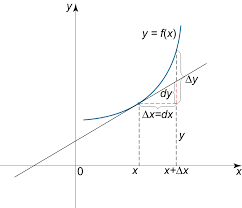Differentials
Differentials:In calculus, the differential represents the principal part of the change in a function y = f(x) with respect to changes in the independent variable. The dif...

limx→4x2−16x−4limx→∞4x2−5x1−3x2
In the first limit if we plugged in x=4 we would get 0/0 and in the second limit if we “plugged” in infinity we would get ∞/−∞ (recall that as x goes to infinity a polynomial will behave in the same fashion that its largest power behaves). Both of these are called indeterminate forms. In both of these cases there are competing interests or rules and it’s not clear which will win out.
In the case of 0/0 we typically think of a fraction that has a numerator of zero as being zero. However, we also tend to think of fractions in which the denominator is going to zero, in the limit, as infinity or might not exist at all. Likewise, we tend to think of a fraction in which the numerator and denominator are the same as one. So, which will win out? Or will neither win out and they all “cancel out” and the limit will reach some other value?
In the case of ∞/−∞ we have a similar set of problems. If the numerator of a fraction is going to infinity we tend to think of the whole fraction going to infinity. Also, if the denominator is going to infinity, in the limit, we tend to think of the fraction as going to zero. We also have the case of a fraction in which the numerator and denominator are the same (ignoring the minus sign) and so we might get -1. Again, it’s not clear which of these will win out, if any of them will win out.
With the second limit there is the further problem that infinity isn’t really a number and so we really shouldn’t even treat it like a number. Much of the time it simply won’t behave as we would expect it to if it was a number.
This is the problem with indeterminate forms. It’s just not clear what is happening in the limit. There are other types of indeterminate forms as well. Some other types are,
(0)(±∞)1∞00∞0∞−∞
These all have competing interests or rules that tell us what should happen and it’s just not clear which, if any, of the interests or rules will win out. The topic of this section is how to deal with these kinds of limits.
As already pointed out we do know how to deal with some kinds of indeterminate forms already. For the two limits above we work them as follows.
limx→4x2−16x−4=limx→4(x+4)=8limx→∞4x2−5x1−3x2=limx→∞4−5x1x2−3=−43
In the first case we simply factored, canceled and took the limit and in the second case we factored out an x2from both the numerator and the denominator and took the limit. Notice as well that none of the competing interests or rules in these cases won out! That is often the case.
So, we can deal with some of these. However, what about the following two limits.
limx→0sinxxlimx→∞exx2
This first is a 0/0 indeterminate form, but we can’t factor this one. The second is an ∞/∞ indeterminate form, but we can’t just factor an x2out of the numerator. So, nothing that we’ve got in our bag of tricks will work with these two limits.
This is where the L hospital's rule comes into play.
L Hospital's Rule:
Suppose that we have one of the following cases,
limx→af(x)g(x)=00ORlimx→af(x)g(x)=±∞±∞where a can be any real number, infinity or negative infinity. In these cases we have,
limx→af(x)g(x)=limx→af′(x)g′(x)So, L’Hospital’s Rule tells us that if we have an indeterminate form 0/0 or ∞/∞ all we need to do is differentiate the numerator and differentiate the denominator and then take the limit.
The 0/0 form(L hospital's rule):
if f(x) and g(x) and also their derivatives f'(x) and g'(x) are continuous at x=a and if f(a)=g(a)=0,then prove that g'(x) doesn't equal to 0

If f'(a) and g'(a) are both zero then the above theorem can further be used. Thus, provided that f ''(x) and g ''(x) both are continuous at x=a ang g ''(a) doesn't equal to 0.This theorem can further be used if f ''(a)=g ''(a)=0.
